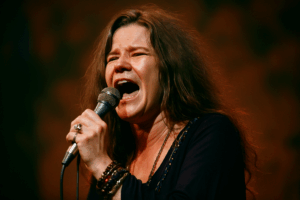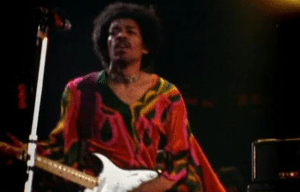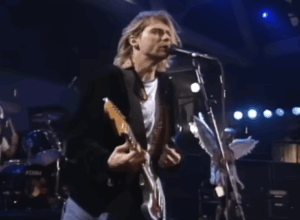Jerry Garcia’s List Of Favorite Albums

via Garloo / YouTube
Jerry Garcia wasn’t just a musician; he was a true connoisseur of sound. As the driving force behind The Grateful Dead, Garcia’s passion for music extended far beyond performance, reaching into a deep appreciation for the vast and varied world of recorded works. His love for exploring new sounds and styles shaped his artistic journey and left a lasting legacy.
Throughout his career, Garcia constantly evolved, experimenting with different styles and ideas both on stage and in the studio. This creative flexibility was fueled by his insatiable curiosity and his dedication to listening, learning, and drawing inspiration from a wide range of music. His work with The Grateful Dead reflects a mind that was always reaching for something new and unexpected.
Garcia’s legendary record collection, which reportedly housed thousands of albums, was a testament to his boundless enthusiasm for music. From classic rock staples to obscure gems, he absorbed it all, using these influences to inform his groundbreaking sound. Here’s a glimpse into the albums that inspired one of rock’s most innovative minds.
https://twitter.com/CPapasergio/status/1816782574099829142
Folksingers ‘Round Harvard Square – Joan Baez, Bill Wood, Ted Alevizos (1959)
Joan Baez’s debut album, Folksingers ‘Round Harvard Square, released in 1960, is a cornerstone of the folk music revival. The album features a collection of traditional songs that resonate with themes of social justice and personal introspection, which deeply influenced young artists like Jerry Garcia.
The album includes notable tracks such as “Silver Dagger” and “East Virginia,” which showcase Baez’s ability to convey deep emotional truths through her performances. Garcia admired Baez not just for her vocal prowess but also for her activism and commitment to social causes, which paralleled his own values. As folk music gained traction in the 1960s, Baez’s work served as a significant influence on Garcia’s artistic development, helping shape his approach to songwriting and performance.
Garcia often reflected on the impact of folk music on his life and career, stating that it provided a foundation for his musical explorations. The sincerity and authenticity found in Baez’s Folksingers ‘Round Harvard Square resonated with him, reinforcing his belief that music could be a powerful tool for change.
Anthology of American Folk Music – Various Artists (Compiled by Harry Smith, 1952)
Harry Smith’s Anthology of American Folk Music, released in 1952, is a landmark collection that played a pivotal role in the folk revival of the 1960s. This compilation features an extensive array of American folk music recordings from various artists, capturing the essence of traditional songs that reflect the diverse cultural tapestry of the United States.
For Jerry Garcia, this anthology was more than just a collection; it was an essential resource that introduced him to the roots of American music. The anthology spans multiple genres and styles, showcasing everything from blues to ballads, which greatly influenced Garcia’s musical palette. Smith’s meticulous curation highlighted the importance of preserving these traditional sounds and stories, inspiring Garcia to explore similar themes in his own work with the Grateful Dead.
Garcia often cited Smith’s anthology as a crucial influence on his understanding of folk music and its cultural significance. The Anthology of Folk Music not only informed his musical sensibilities but also encouraged him to delve deeper into the roots of American musical heritage, shaping his identity as an artist who valued both innovation and tradition.
Smiley Smile – The Beach Boys (1967)
Released in 1967, Smiley Smile by The Beach Boys represents a unique departure from their earlier surf rock sound, embracing experimental elements that intrigued Jerry Garcia. The album features whimsical melodies and innovative production techniques that reflect the band’s evolving artistic vision.
The album includes iconic tracks like “Good Vibrations” and “Heroes and Villains,” showcasing Brian Wilson’s genius in crafting complex harmonies and intricate arrangements. Garcia appreciated how The Beach Boys pushed musical boundaries while maintaining an accessible sound that resonated with listeners.
Garcia’s admiration for Smiley Smile speaks to his broader appreciation for artists who dared to innovate within their genres. The Beach Boys’ willingness to embrace change inspired him to explore new directions in his music, ultimately contributing to the eclectic sound that characterized both his solo work and that of the Grateful Dead.
Bringing It All Back Home – Bob Dylan (1965)
Bob Dylan’s Bringing It All Back Home, released in 1965, marks a significant moment in rock history with its fusion of folk and electric sounds. For Jerry Garcia, Dylan was not just another musician; he was a lyrical visionary whose work profoundly influenced Garcia’s songwriting approach. This album features iconic tracks such as “Subterranean Homesick Blues” and “Mr. Tambourine Man,” showcasing Dylan’s ability to weave complex narratives with social commentary.
Garcia was particularly drawn to Dylan’s poetic lyrics and innovative soundscapes, which encouraged him to experiment with storytelling in his own music. The blend of acoustic and electric instrumentation on this record resonated with Garcia during a time when he was navigating his own artistic identity within the burgeoning counterculture movement.
Dylan’s influence extended beyond mere admiration; it shaped how Garcia approached songwriting within the Grateful Dead. The lyrical depth found in Bringing It All Back Home encouraged him to infuse his own compositions with rich imagery and emotional resonance, solidifying Dylan’s place as one of Garcia’s most significant inspirations.
Cahoots – The Band (1971)
Cahoots, released by The Band in 1971, is an album that showcases their unique blend of rock, folk, and Americana influences. Jerry Garcia was an avid fan of The Band, appreciating their ability to craft songs that resonated with authenticity and emotional depth. While he admired much of their catalog, it was Cahoots that particularly captivated him due to its innovative arrangements and collaborative spirit.
The album features standout tracks like “Life Is A Carnival” and “When I Paint My Masterpiece,” both reflecting The Band’s knack for storytelling through music. Garcia admired how they seamlessly integrated various musical styles while maintaining a cohesive sound. This ability to transcend genres resonated deeply with him as he sought to create music that defied categorization within the Grateful Dead.
Garcia often expressed how The Band’s work inspired him creatively, pushing him to explore new sounds and collaborations within his own projects. Their influence is evident in Garcia’s willingness to experiment with different musical forms while remaining rooted in authentic storytelling—a hallmark of both artists’ legacies.
John Lennon/Plastic Ono Band – John Lennon (1970)
John Lennon’s Plastic Ono Band, released in 1970, is widely regarded as one of the most introspective albums in rock history. Jerry Garcia held this record in high regard, appreciating its raw emotional honesty and groundbreaking approach to songwriting. Lennon’s departure from The Beatles marked a significant shift toward personal expression in his music, which resonated deeply with Garcia during a period of artistic exploration.
The album features poignant tracks such as “Mother” and “Working Class Hero,” where Lennon confronts personal trauma and societal issues head-on. For Garcia, Lennon’s willingness to expose vulnerability through music served as an inspiration for his own songwriting journey within the Grateful Dead. He admired how Lennon crafted melodies that were both beautiful and hauntingly reflective.
Garcia often remarked on the beauty found within Lennon’s solo work compared to his time with The Beatles. He believed that Plastic Ono Band encapsulated Lennon’s artistic evolution—one that encouraged musicians like himself to embrace authenticity and vulnerability in their creative expressions.
Fleetwood Mac – Fleetwood Mac (1975)
Fleetwood Mac’s self-titled debut album released in 1975 marked a pivotal moment for the band as they began transitioning into mainstream success. Jerry Garcia was captivated by Fleetwood Mac’s unique sound blending rock with blues influences, which mirrored some aspects of his own musical journey with the Grateful Dead. This self-titled album showcased their ability to craft catchy melodies while maintaining depth—a quality that resonated strongly with Garcia.
Tracks like “Monday Morning” demonstrate Fleetwood Mac’s knack for infectious hooks paired with thoughtful lyrics about love and loss. Garcia appreciated how they balanced commercial appeal with artistic integrity—a trait he sought throughout his career as well. Their innovative approach inspired him during recording sessions for Grateful Dead albums like Terrapin Station, where they sought out producer Keith Olsen based on Fleetwood Mac’s success.
Garcia recognized Fleetwood Mac not only for their musical talent but also for their ability to evolve over time while staying true to their roots. Their influence encouraged him to embrace change within his own projects while remaining connected to authentic storytelling—a hallmark characteristic shared between both artists.
The Wall – Pink Floyd (1979)
Pink Floyd’s The Wall, released in 1979, stands as one of rock history’s most ambitious concept albums exploring themes of isolation and alienation. By 1981 when Jerry Garcia expressed admiration for this record, he had transitioned into an elder statesman within the music scene—his tastes having shifted from seeking out new sounds toward revisiting cherished classics from earlier decades.
The album features iconic tracks such as “Another Brick in the Wall” which critiques educational systems while encapsulating feelings shared by many listeners experiencing societal pressures during that era—a sentiment echoed across generations since its release date over four decades ago now! For Garcia—the grandiosity found within Pink Floyd’s compositions served as both inspiration & reflection upon life experiences—encouraging deeper introspection through art itself rather than simply entertainment value alone.
While it may have been true that by this point—Garcia had grown weary regarding newer releases—his appreciation towards Pink Floyd remained unwavering! Their ability at creating immersive sonic landscapes allowed listeners like himself an escape route into realms beyond reality—where emotions could be explored freely without boundaries imposed upon them externally.
Between the Buttons – The Rolling Stones (1967)
Released in 1967, Between the Buttons by The Rolling Stones showcases their distinctive blend of rock ‘n’ roll infused with pop sensibilities—a style that captivated Jerry Garcia throughout various points during his career! This album features notable tracks such as “Ruby Tuesday” & “Let’s Spend the Night Together,” highlighting Mick Jagger’s charismatic vocals alongside Keith Richards’ innovative guitar work.
For Garcia—this record represented more than just enjoyable tunes; it symbolized youthful rebellion against societal norms prevalent at that time. The Stones’ willingness towards experimentation within songwriting resonated deeply with him—as they pushed boundaries surrounding traditional structures while still maintaining catchy hooks. Their unique approach inspired countless musicians—including members of the Grateful Dead—who sought similar freedom when crafting original material themselves.
Additionally—Garcia admired how Jagger effortlessly navigated between different genres—from bluesy ballads through upbeat rockers—all while retaining authenticity throughout each performance. Garcia often cited artists like the Jagger/Richards duo among those who shaped modern rock culture significantly.
Hoodoo Man Blues – Junior Wells (1965)
Released in 1965, Junior Wells’ Hoodoo Man Blues is considered one of the defining albums within Chicago blues—a genre deeply rooted in American musical history. For Jerry Garcia—this record served as an essential touchstone reflecting the raw emotion & energy found throughout Wells’ performances. Featuring standout tracks such as “Hoodoo Man Blues” & “You’re Telling Me,” Wells’ gritty vocals combined seamlessly alongside powerful instrumentation captured audiences’ hearts—including those belonging to Grateful Dead fans.
Wells’ ability at conveying heartfelt narratives through song allowed listeners access into personal experiences surrounding love/loss while simultaneously providing insight into broader societal issues faced during mid-20th century America. For Garcia—these elements represented core values surrounding artistry itself—where honesty prevailed over superficiality. His admiration towards Wells extended beyond mere enjoyment; it inspired deeper exploration into blues traditions influencing future projects undertaken alongside fellow musicians throughout career.











